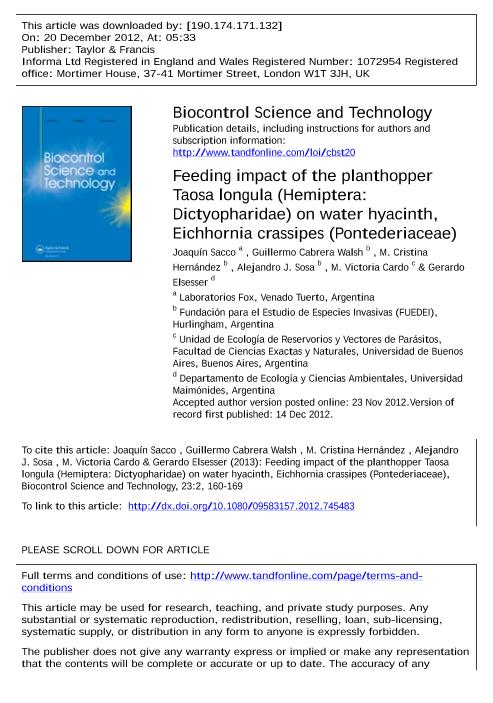Mostrar el registro sencillo del ítem
dc.contributor.author
Sacco, Joaquín
dc.contributor.author
Cabrera Walsh, Guillermo José

dc.contributor.author
Hernández, M. Cristina
dc.contributor.author
Sosa, Alejandro Joaquín

dc.contributor.author
Cardo, María Victoria

dc.contributor.author
Elsesser, Gerardo
dc.date.available
2017-07-19T15:33:19Z
dc.date.issued
2013-01
dc.identifier.citation
Sacco, Joaquín; Cabrera Walsh, Guillermo José; Hernández, M. Cristina; Sosa, Alejandro Joaquín; Cardo, María Victoria; et al.; Feeding impact of the planthopper Taosa longula (Hemiptera: Dictyopharidae) on water hyacinth, Eichhornia crassipes (Pontederiaceae); Taylor & Francis; Biocontrol Science and Technology; 23; 2; 1-2013; 160-169
dc.identifier.issn
0958-3157
dc.identifier.uri
http://hdl.handle.net/11336/20922
dc.description.abstract
Taosa longula Remes Lenicov (Hemiptera: Dictyopharidae), a planthopper native to South America, is a candidate for the biological control of water hyacinth, Eichhornia crassipes (Mart.) Solms-Laubach (Pontederiaceae), a serious weed worldwide. Biological control requires agents that are not only specific but also effective. Damage caused by sap-sucking insects is difficult to assess. In this work we designed an experimental and analytical procedure to evaluate the potential damage of T. longula on water hyacinth. The damage that T. longula causes to the clonal reproduction, biomass production, and growth of water hyacinth was studied through a paired greenhouse trial with floating cages. The performance of the plant, starting from two plants per treatment, was evaluated at different insect densities (5, 10, 15 and 20 nymphs per cage) until all the nymphs moulted to adults. The tests showed that individual growth and biomass production of water hyacinth was reduced due to the effect of the insect feeding above five nymphs per cage. The number of new plants produced by clonal reproduction was only significantly different above 15 nymphs per cage. These results suggest that this planthopper could be an effective agent for the biological control of water hyacinth.
dc.format
application/pdf
dc.language.iso
eng
dc.publisher
Taylor & Francis

dc.rights
info:eu-repo/semantics/openAccess
dc.rights.uri
https://creativecommons.org/licenses/by-nc-sa/2.5/ar/
dc.subject
Water Hyacinth Biocontrol
dc.subject
Hemipteran Feeding Damage
dc.subject
Paired Feeding Tests
dc.subject.classification
Ecología

dc.subject.classification
Ciencias Biológicas

dc.subject.classification
CIENCIAS NATURALES Y EXACTAS

dc.title
Feeding impact of the planthopper Taosa longula (Hemiptera: Dictyopharidae) on water hyacinth, Eichhornia crassipes (Pontederiaceae)
dc.type
info:eu-repo/semantics/article
dc.type
info:ar-repo/semantics/artículo
dc.type
info:eu-repo/semantics/publishedVersion
dc.date.updated
2017-07-18T20:06:43Z
dc.journal.volume
23
dc.journal.number
2
dc.journal.pagination
160-169
dc.journal.pais
Reino Unido

dc.journal.ciudad
Londres
dc.description.fil
Fil: Sacco, Joaquín. Laboratorios Fox; Argentina
dc.description.fil
Fil: Cabrera Walsh, Guillermo José. Fundación para el Estudio de Especies Invasivas; Argentina
dc.description.fil
Fil: Hernández, M. Cristina. Fundación para el Estudio de Especies Invasivas; Argentina
dc.description.fil
Fil: Sosa, Alejandro Joaquín. Fundación para el Estudio de Especies Invasivas; Argentina. Consejo Nacional de Investigaciones Científicas y Técnicas; Argentina
dc.description.fil
Fil: Cardo, María Victoria. Universidad de Buenos Aires. Facultad de Ciencias Exactas y Naturales; Argentina. Consejo Nacional de Investigaciones Científicas y Técnicas; Argentina
dc.description.fil
Fil: Elsesser, Gerardo. Universidad Maimónides; Argentina
dc.journal.title
Biocontrol Science and Technology

dc.relation.alternativeid
info:eu-repo/semantics/altIdentifier/url/http://www.tandfonline.com/doi/abs/10.1080/09583157.2012.745483
dc.relation.alternativeid
info:eu-repo/semantics/altIdentifier/doi/http://dx.doi.org/10.1080/09583157.2012.745483
Archivos asociados
